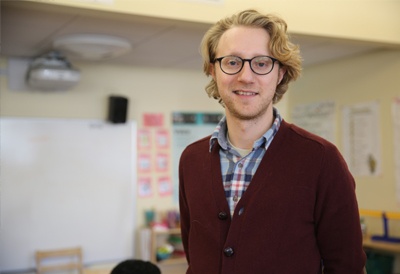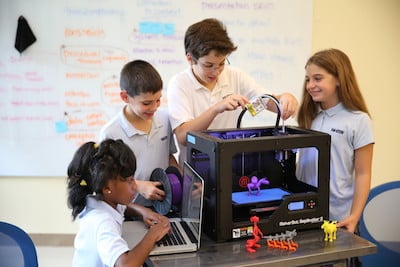A few years ago when we opened our new Design Technology lab, we introduced 3D printers to our students to give them an opportunity to develop design thinking and become makers.
Our focus throughout the program has been to make sure that kids use 3D printers within the scope of teaching and learning (not just to give them a chance to play with cutting-edge technology.)
There may not be a 3D printer in every home yet, but more and more households have young people in them who see a 3D printer as just another tool, like a hammer or a Web browser. These children know how to have an idea, give it a physical form, and keep making it better. One generation’s magic trick is the next generation’s normal. - Makerbot CEO Jonathan Jaglo about his visit to see the 3D printing program at Whitby School
In our classroom units, we make sure 3D printers are tied to a greater idea and contextualized so that students learn to think and create as they learn the technology.
We’ve seen such enthusiasm for the 3D printers from students that we’ve started offering an intensive 3D printer program during our summer camp session.
A Look inside the 3D Printing Summer Camp at Whitby
Travis Sluss, owner of MacInspires, spoke with us about the 3D printing camp his company will teach during our 2018 Summer Day Camp program.
Whitby: What’s the best part of teaching 3D printing to kids?

Travis: When we teach 3D printing, we start by showing kids 10-15 minutes of tips and tricks and they just go from there. It’s fun to see what they create—kids often end up inspiring us and showing us really cool things. Often by the end of their first class they can actually make something.
Whitby: How do you get kids into 3D printing?
Travis: During the camp, we start with having kids build a home. Drawing a house is really simple because it’s based on basic shapes that anyone can create. Plus everyone is familiar with a home — as opposed to asking kids to design a robot or a car.
A house also gives kids a lot of room for creativity. It starts off like a normal home like when you draw like a kid. Then we expand from that. Kids can make the house in a way that’s modeled after their home or their dream home or even design a home that’s really wild and unique.

Whitby School: What’s the process you go through to teach kids 3D printing?
Travis: We start by giving kids the tools to learn how to make the elements for the house. Then we tell them to go for it, and to ask if they have questions.
Just like any other art form, kids have to learn 3D printing step-by-step. So we start by giving kids set projects in the beginning, like a house, robot or a droid from Star Wars. Then we let them add different shapes and different windows. As an example, we’ve had kids build their own city block in Manhattan.
3D printing is a lot like learning to play an instrument—you can’t learn how to play it all at once.
Once kids have enough experience to get started, we give them some free time to make whatever they want.
After that, we challenge them to make something where the measurements are really important. To create a 3D print design that will work with something in the real world, you have to be really precise. With a 3D printed car that has a wheel and axles, you print each piece separately and glue them together. It’s difficult because the wheels have to fit on the axles and the axles have to fit into the body of the car. It takes precision.
Whitby: With all the 3D printing plans available online, how do you ensure kids use their creativity?
Travis: We have a rule in the camp. For kids to take something home, it has to be something they spend at least half the class making their own. Because the prints take so long (about an hour and a half), we want to make sure that kids get the best educational value from their time.
Whitby: What are the benefits of attending 3D printing camp?
Travis: In addition to learning how to use a 3D printer, campers learn life skills. For example, failing happens often in 3D printing and design. It’s hard to see 3D dimensions on a flat screen, so kids will create a design that looks good from one angle, but not another. Then they just have to get back on the horse and try again.

3D printing also teaches patience. Most of the kids in our camp are in elementary and middle school and the majority of our 3D prints are about the the size of their fist. Each 3D print takes about an hour and a half to create and it takes about 10-20 hours to print for the entire class.
We use additive manufacturing, which adds layers of plastic about the width of your hair on top of each other. As a result, kids can clearly see why the printing takes so long—which helps build their patience. Our rule is that “No one will get a print until everyone gets a print.” Kids learn that if they make something, they will get it two weeks later.
Whitby: What academic skills do kids practice at 3D printing camp?
Travis: 3D printing is all about shapes and measurements, so kids practice a lot of math as they learn to make new designs. Math is especially important when they want to make things that fit into the real world, such as a working toy car, a toothbrush holder or a bookend.
Kids also learn the importance of scaling and measurement. When you design something on a computer, it doesn’t matter how large or small you make it because you can scale it to whatever size you need. But when you’re designing something that has to fit into something else, you have to get the measurements exactly right—or you have to start from the beginning because the piece you made didn’t fit.
3D printing also teaches kids about physics and chemistry as they see liquids turn to solids in only five minutes. The entire process of 3D printing is educational—it’s one of the most hands-on ways out there to get kids to practice math, measurement and design while using technology.
Sign Up Your Child to Learn 3D Printing This Summer
If your child wants to get flex their creative muscle and experience this very cool, cutting-edge technology, consider enrolling them in Whitby’s 3D printing summer day camp this summer.

